BISAC NAT010000 Ecology
BISAC NAT045050 Ecosystems & Habitats / Coastal Regions & Shorelines
BISAC NAT025000 Ecosystems & Habitats / Oceans & Seas
BISAC NAT045030 Ecosystems & Habitats / Polar Regions
BISAC SCI081000 Earth Sciences / Hydrology
BISAC SCI092000 Global Warming & Climate Change
BISAC SCI020000 Life Sciences / Ecology
BISAC SCI039000 Life Sciences / Marine Biology
BISAC SOC053000 Regional Studies
BISAC TEC060000 Marine & Naval
A model of an artificial beach is suggested for protection of coasts under erosion due to intense storm surges. It is shown that the coarser beach sand results in decrease of the beach width and growth of nourishment volume. At the same time relative material loss due to long-shore sediment transport diminishes too. The model has been applied to three sections of the coasts of Kurortny district of S.-Petersburg (eastern part of the Gulf of Finland). It recommends medium sand for the beaches construction. Modeling of extreme storms effect shows only minor deformations for designed beach profiles. For the beaches more than 1 km long even in 30-50 years more than a half of the initial beach volume conserves without additional nourishment.
sand coast, artificial beach, beach profile, sediment flux, Gulf of Finland.
- INTRODUCTION
Artificial beaches are widely applicable in the coastal protection practice for minimizing storm effect [1], [2]. Actual Russian recommendations for calculation of beach profiles [3] are related to coasts with no sea level changes. But there are a lot of coasts with dynamics governed by high storm surges. One of the examples is the coast of Kurortny district of S.-Petersburg in the eastern part of the Gulf of Finland (Fig. 1) which undergoes significant erosion [4], [5].
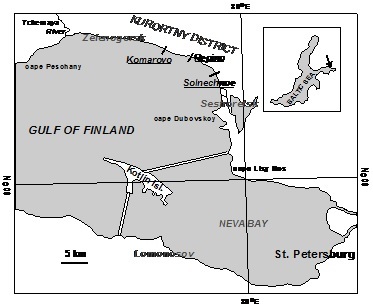
Fig. 1. The coast of the eastern Gulf of Finland and location of designed profiles Komarovo, Repino and Solnechnoe.
The actual situation could be improved by construction of artificial sand beaches at vulnerable segments of the coast. But, for the surges higher than wave height, prediction of stable beach parameters is hardly possible on a base of traditional methods. In this paper a model of a stable beach is suggested and applied to three segments of the Kurortny district coast (Fig. 1). Effectiveness of the modeled beaches verified by means of mathematical modeling of the extreme storm action on the coast.
- A MODEL OF A STABLE BEACH
Profile geometry. A scheme of profiles of natural and designed beaches is given in Fig. 2. An elevation z is measured from the lower still water level and horizontal distance x is counted off seaward from the highest beach point which is the sum of the storm surge η and wave run-up R heights.
A horizontal segment la corresponds to the berm width. Its variations allow displacement of the whole designed profile seaward or landward in order to achieve its intersection with the natural profile in the closure depth. The latter bounds the area of significant sea bed deformations.

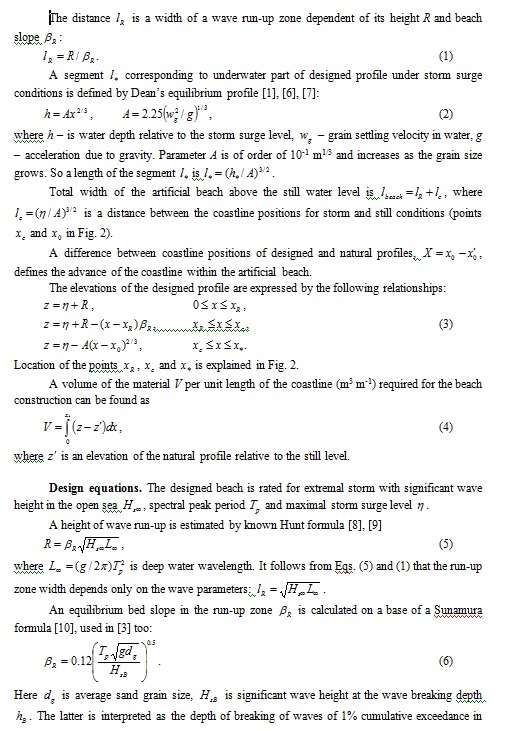
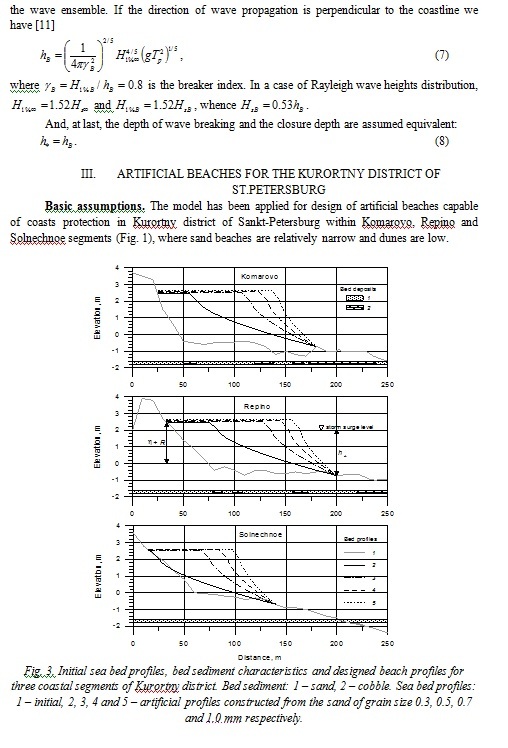
Typical sea bed profiles and bed sediment properties are represented in Fig. 3. They are based on monitoring data of the coastal zone collected for a number of years by A.P.Karpinsky Russian Geological Research Institute (VSEGEI) in Saint-Petersburg [12]. The storms accompanied by the surge of about 2 m height inflict the most valuable damage for the coasts. This kind of storms occurred approximately once every 25 years [13] but in the last decades their frequency at least doubled [5]. Parameters of the extreme event peak are the following [4]:

Table 1. The designed parameters of artificial beach profiles for different sand grain size
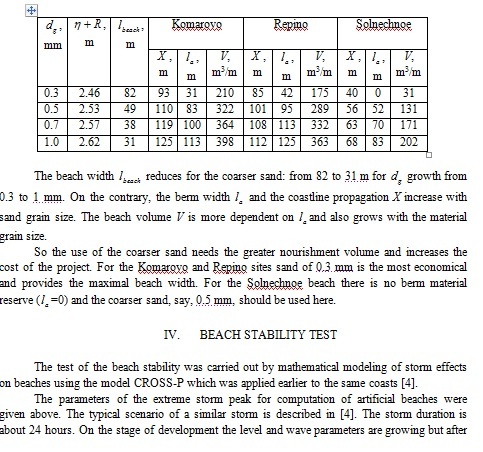
the peak passes all the parameters reduce. Angles of wave approach relative to the normal to the coastline can be taken as 45º for Komarovo and Repino and 15º for Solnechnoe.
The beach profiles constructed from 0.3 and 0.5 mm sand where taken as initial. The modeling results are shown in Fig. 4.
It can bee seen that the storm action results in relatively minor variations of the profile morphology. Maximal deformations don’t exceed 0.5 m. Slight erosion of the upper part of the beach and some sediment transport downward the slope don’t lead to appreciable material loss. In comparison, the same storm effect on natural (unprotected) beach can cause several meters retreat of the front foredune slope [12], [4]. Apparently, the beaches designed can withstand more than one severe storm attack and their lifetime is evidently longer than the return period of extreme storms (of order 10 years).
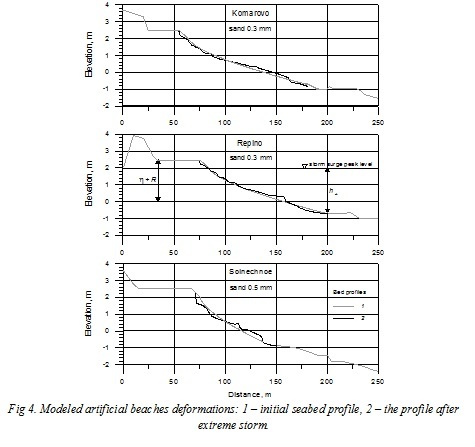
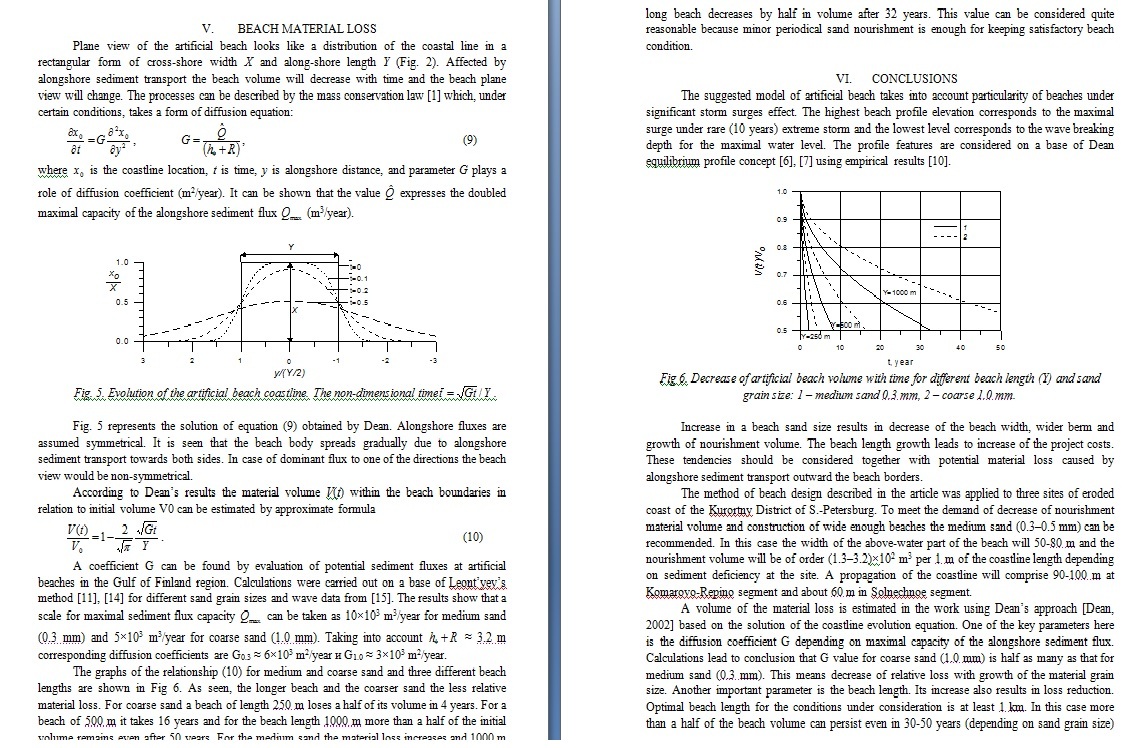
without additional feeding. In the same time a beach of length 250 m will require every year nourishment amount of more than 25% of initial volume.
A stability of the designed beaches is verified by modeling of extreme storm effect. It was revealed that the beach profiles undergo only minor deformations and can keep their resource for a sufficiently long time that exceeds the return period of extreme events.
ACKNOWLEDGEMENT
The work is supported by RSCF (Grant # 14-17-00547).
1. Dean R.G. 2002. Beach Nourishment: Theory and Practice. World Scientific Inc. 2002. 399 p.
2. Khabidov A.Sh., Leont’yev I.O., Marusin K.V., Shlychkov V.A., Savkin V.M., Kuskovskiy V.C. 2009. Man-made Lake Shore Management. Novosibirsk. Pub. House SB RAS, 2009. 239 p.
3. Set of Rules. 2009. «Design of Sea Protective Constructions». SP 32-103-97. NIC «Sea coasts». TSNIIS. 1997. 141 s.
4. Leont’yev I.O., Ryabchuk D.V., Sergeev A.Yu. 2015. Modeling of Storm-Induced Deformations of a Sandy Coast (Based on the Example of the Eastern Gulf of Finland). Oceanology. 2015. V. 55. № 1. P. 131-141.
5. Leont’yev I.O., Ryabchuk D.V., Sergeev A.Yu., Kovaleva O.A. 2015. The Forecast of Coastal Recession in the Eastern Gulf of Finland for the Twenty-First Century. Oceanology. 2015. V. 55. № 3. P. 434-440.
6. Dean R.G. 1991. Equilibrium Beach Profiles. Characteristics and Applications // J. of Coastal Res. 1991. V. 7. № 1. P. 53-84.
7. Kriebel D.L., Kraus N.C., Larson M. 1991. Engineering Methods for Predicting Beach Profile Response. Int. Conf. “Coastal Sediments’91”. Seattle. 1991. P. 557-571.
8. Hunt I.A. 1959. Design of Seawalls and Breakwaters. J. of Waterway and Harbors Div. 1959. V. 85. P. 123-152.
9. Leont’yev I.O. 2001. Coastal Dynamics: Waves, Currents, Sediment Transport. M.: GEOS, 2001. 272 p.
10. Sunamura T. 1989. Sandy Beach Geomorphology Elucidated by Laboratory Modeling. In: Coastal Modeling: Techniques and Applications. Lakhan V.C., Trenhail A.S. (Eds). Elsevier, Amsterdam. 1989. P. 159-213.
11. Leont’yev I.O. 2014. Morphodynamic Processes in the Coastal Zone of the Sea. Saarbrücken: LAP LAMBERT Academic Publishing. 2014. 251 c. ISBN: 978-3-659-62831-3.
12. Ryabchuk D.V., Kolesov A.M., Sergeev A.Yu. et al. 2012. Abrasion Processes in the Coastal Zone of the Western Gulf of Finland and their Connection with Long-term Tendencies of the Key Regime Factors. Geomorphology, 2012. № 4. P. 99-105.
13. Barkov L.K. 1991. Lithodynamic Processes in the Coastal Zone of the Western Part of the Gulf of Finland from c. Lautaranta to c. Dubrovsky. Proc. RGS. 1991. V. 123. Issue 1. P. 60-67.
14. Leont’yev I.O. 2014. Calculation of Longshore Sediment Transport. Oceanology. 2014. V. 54. № 2. P. 226-232.
15. Leont’yev I.O. 2008. An Estimate of the Cross-shore Sediment Flux at the Boundary of the Coastal Zone. Oceanology 2008. V. 48. № 1. P. 123-126.







